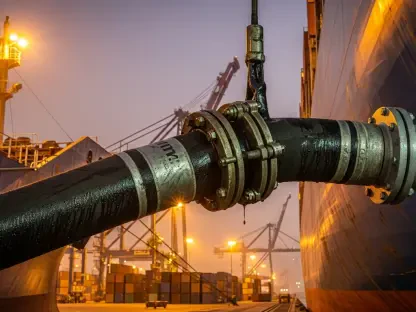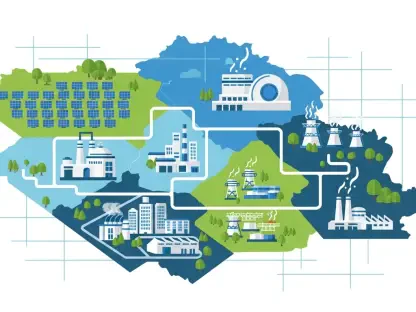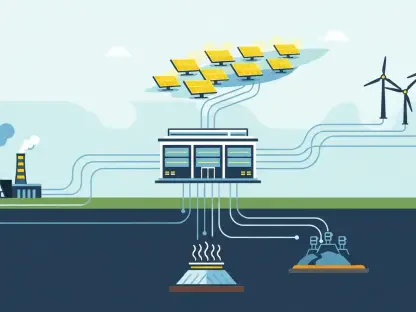What if the skies over India, buzzing with one of the world’s fastest-growing aviation markets, could become a canvas for cleaner air and a shield against oil dependency? As air travel demand skyrockets across the nation, the carbon footprint of this industry looms large, contributing significantly to greenhouse gas emissions. Sustainable Aviation Fuel (SAF), a renewable alternative to traditional jet fuel, emerges as a game-changer, promising to cut emissions by up to 80% over its lifecycle. This shift isn’t just about technology—it’s about reimagining energy security for a country heavily reliant on imported crude. The stakes are high, and the journey toward SAF adoption offers a glimpse into India’s bold environmental and economic ambitions.
The urgency of this transition cannot be overstated. With aviation emissions projected to triple by 2050 if unchecked, India stands at a critical juncture to lead by example in the global push for decarbonization. Beyond the environmental impact, the move toward SAF ties into reducing fuel costs for airlines and fostering rural development through local feedstock production. This narrative isn’t merely about fuel—it’s about reshaping an industry, supporting farmers, and aligning with international climate goals. The following sections delve into how India plans to roll out this transformation, drawing lessons from past successes and charting a path for a greener future.
Why Sustainable Aviation Fuel Matters for India
The aviation sector in India is a powerhouse of growth, with passenger numbers expected to double in the next decade. Yet, this boom comes at a steep environmental cost, as jet fuel remains a major source of carbon emissions. SAF, derived from renewable sources like used cooking oil and agricultural waste, offers a viable solution to slash this impact while maintaining the efficiency of modern aircraft. The potential to curb pollution in a country grappling with severe air quality issues makes this shift not just desirable, but essential.
Moreover, the adoption of SAF aligns with national priorities beyond the environment. Reducing reliance on imported oil—a significant drain on foreign exchange reserves—can bolster economic stability. For a nation where fuel price volatility affects millions, integrating sustainable alternatives into aviation could stabilize costs for airlines and, ultimately, passengers. This dual benefit of environmental and economic gains positions SAF as a cornerstone of India’s energy strategy.
The global context adds another layer of importance. With international bodies like the International Civil Aviation Organization pushing for net-zero emissions by 2050, India’s commitment to SAF adoption signals its intent to be a responsible player on the world stage. The challenge lies in balancing rapid industry growth with sustainable practices, a tightrope walk that could redefine the future of travel in the region.
India’s Broader Vision for Renewable Energy in Aviation
SAF adoption is not an isolated effort but part of a larger tapestry of renewable energy initiatives in India. The country has set ambitious targets to combat climate change, including a pledge to achieve net-zero emissions by 2070. Aviation, as a hard-to-abate sector, plays a pivotal role in this mission, with SAF serving as a bridge to lower emissions without requiring drastic changes to existing aircraft infrastructure.
This push dovetails with efforts in other sectors, such as the successful Ethanol Blended Petrol program, which has already transformed the automotive fuel landscape. By integrating renewable fuels across industries, India aims to address local challenges like urban air pollution, which affects millions annually. The synergy between these programs highlights a holistic approach to sustainability, where lessons from one sector inform strategies in another.
Economic and social dimensions further enrich this vision. Developing SAF and ethanol production from local feedstocks like agricultural residues can uplift rural communities, turning waste into wealth. This alignment with broader goals of energy independence and rural empowerment underscores why renewable fuels are more than a technical fix—they are a catalyst for systemic change.
India’s Step-by-Step Strategy for SAF Implementation
Transitioning an entire aviation sector to greener fuels requires meticulous planning, and India has outlined a phased approach to ensure a smooth shift. Starting with a modest blending mandate of 1% SAF for international flights by 2027, the target will rise to 2% by 2028, with incremental increases planned as production capacity grows. This gradual rollout, developed in collaboration with the Ministry of Petroleum and Natural Gas, oil companies, airlines, and global technology partners, aims to minimize disruption while building a robust supply chain.
Innovative projects are already paving the way for this transformation. The Indian Oil Corporation’s refinery in Panipat stands out as a pioneer, converting used cooking oil into SAF and demonstrating the feasibility of scalable production. However, challenges remain, particularly in ramping up supply to meet demand and ensuring cost-competitiveness against conventional fuels. Addressing these hurdles will be critical to maintaining momentum in the coming years.
Drawing parallels to the ethanol blending success, the SAF strategy emphasizes collaboration and adaptability. Just as ethanol production scaled through policy support and infrastructure investment, SAF adoption hinges on similar frameworks. With clear timelines and stakeholder engagement, this phased plan offers a realistic blueprint for integrating sustainable fuels into one of the world’s busiest aviation markets.
Insights from Ethanol Success and Expert Perspectives
Union Minister Hardeep Singh Puri has emerged as a staunch advocate for India’s sustainable fuel journey, drawing confidence from the ethanol program’s achievements. Speaking at a recent summit, Puri noted that the early realization of a 20% ethanol blend (E20) by this year—a target initially set for 2030—proves the nation’s capacity for rapid progress. He also countered misconceptions about engine damage with higher blends, pointing to Brazil’s seamless use of a 27% blend as a testament to reliability.
The ethanol initiative’s impact extends beyond technical milestones. Over the past decade, it has saved India approximately $17 billion in foreign exchange by reducing crude oil imports, a figure that highlights the economic stakes of renewable fuels. Projects like the Panipat and Numaligarh 2G ethanol refineries, utilizing agricultural residues, have directly benefited farmers, injecting significant income into rural economies and showcasing a model that SAF could replicate.
These real-world outcomes add weight to expert optimism about SAF’s future. The emphasis on diverse feedstocks, such as maize, which now accounts for 42% of ethanol production compared to none a few years ago, reflects an adaptable approach. Such flexibility, combined with authoritative backing, paints a compelling picture of how past lessons can fuel aviation’s green transition.
Practical Pathways and Future Plans for SAF and Ethanol
Looking ahead, the roadmap for SAF adoption hinges on actionable steps to scale production and ensure industry buy-in. Expanding facilities like the Panipat refinery, fostering partnerships between public and private entities, and meeting incremental blending targets are immediate priorities. These efforts aim to create a sustainable fuel ecosystem that can support both domestic and international aviation needs without straining existing infrastructure.
In parallel, the automotive sector’s shift toward higher ethanol blends offers complementary insights. The development of Flex-Fuel Vehicles, capable of running on blends up to E85, signals readiness for deeper integration, supported by the Ethanol Blending Roadmap spanning from 2025 to 2030. Input from organizations like the Society of Indian Automobile Manufacturers reinforces a consensus on moving toward blends like E25 and E30, ensuring alignment across industries.
The broader vision ties these technical strides to social and economic gains. Transforming farmers into energy producers through feedstock cultivation not only reduces oil dependency but also creates green jobs. By balancing innovation with inclusivity, India’s strategy for SAF and ethanol integration lays a foundation for a future where sustainability drives progress on multiple fronts.
Reflecting on a Sustainable Journey
Looking back, India’s strides in sustainable fuels have marked a defining chapter in its energy narrative. The phased approach to SAF adoption, inspired by the ethanol program’s triumphs, has demonstrated strategic foresight and resilience. Early achievements in blending targets and economic savings of billions in foreign exchange have underscored the power of policy and collaboration.
The environmental wins, from reduced emissions to improved air quality, have laid a tangible foundation for future efforts. Beyond numbers, the empowerment of rural communities through projects like 2G refineries has woven social benefits into the fabric of this transition. These milestones have shown that sustainability is not just an ideal, but a lived reality for millions.
Moving forward, the focus must shift to sustaining this momentum through innovation and investment. Scaling SAF production to meet ambitious mandates, ensuring affordability for airlines, and continuing to support farmers as energy contributors remain critical next steps. As global eyes turn to India’s model, the opportunity to lead in renewable aviation fuels beckons—a chance to redefine not just the skies, but the very trajectory of sustainable development.









